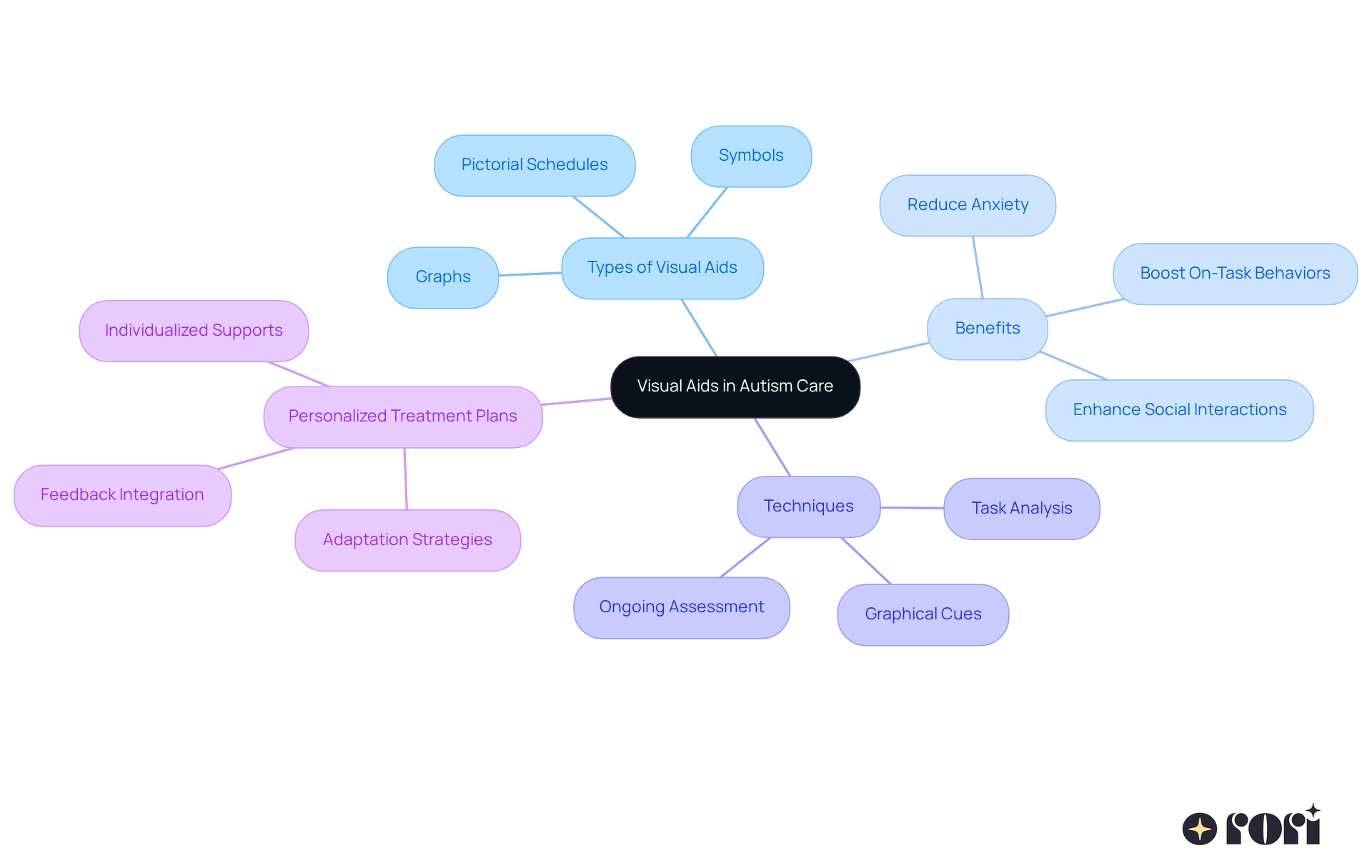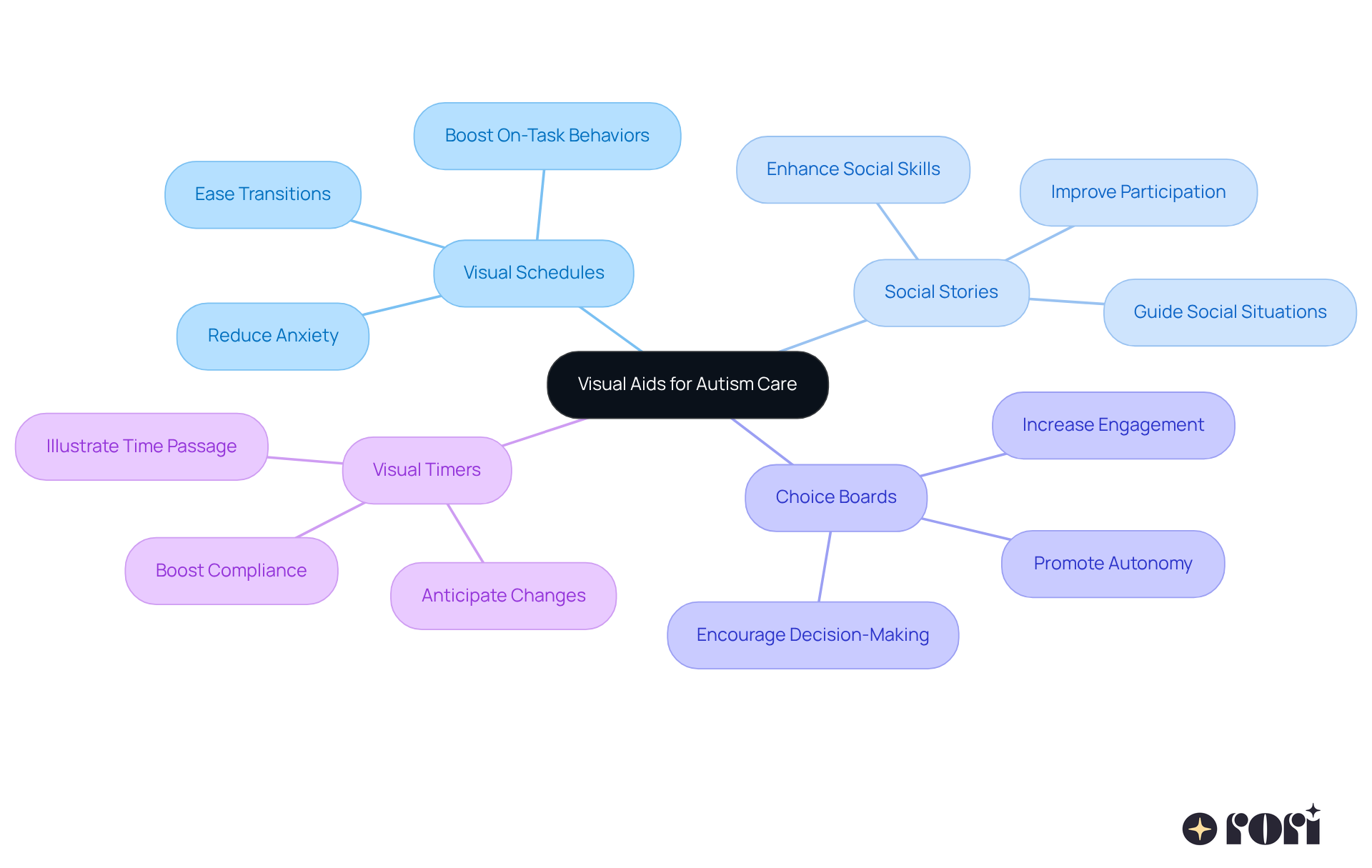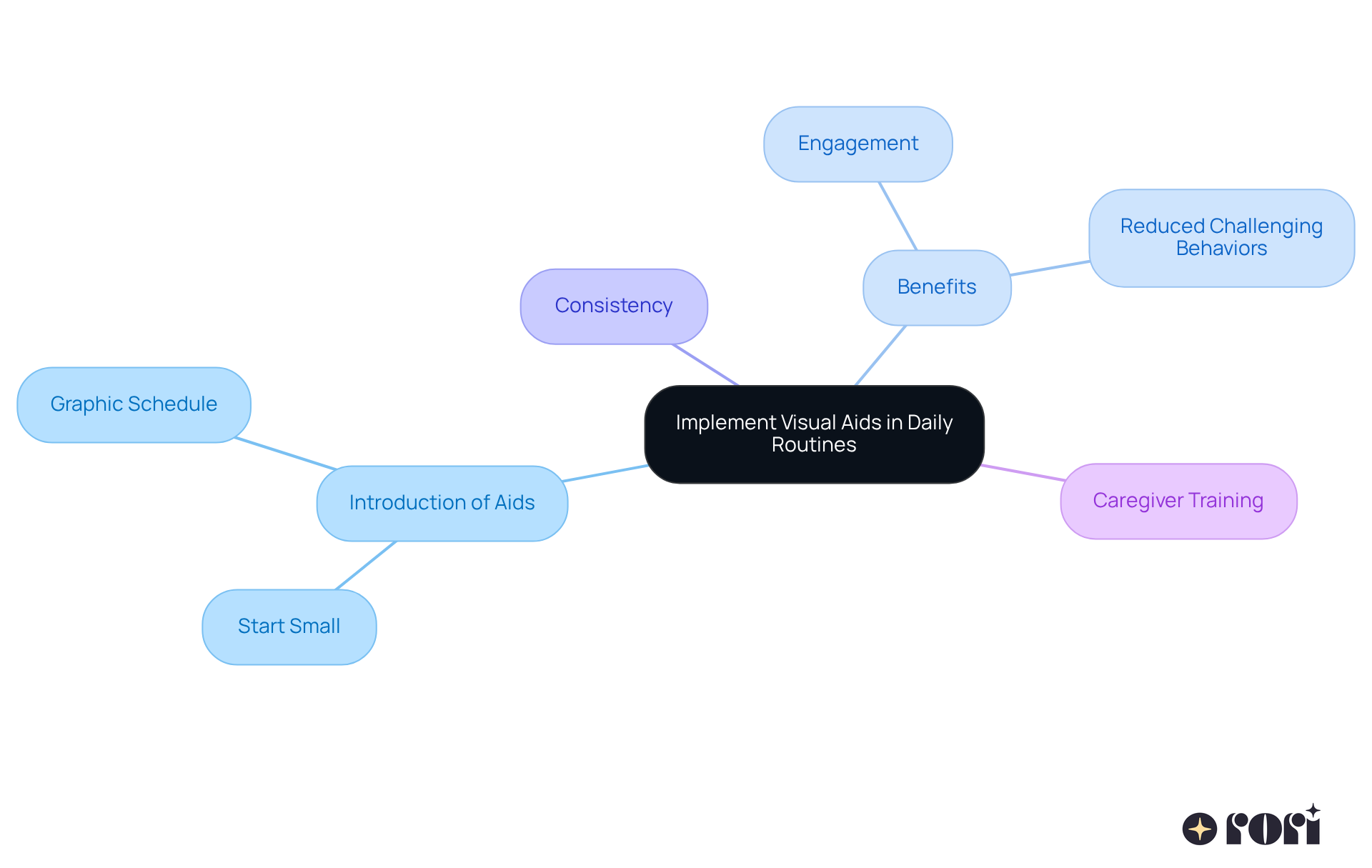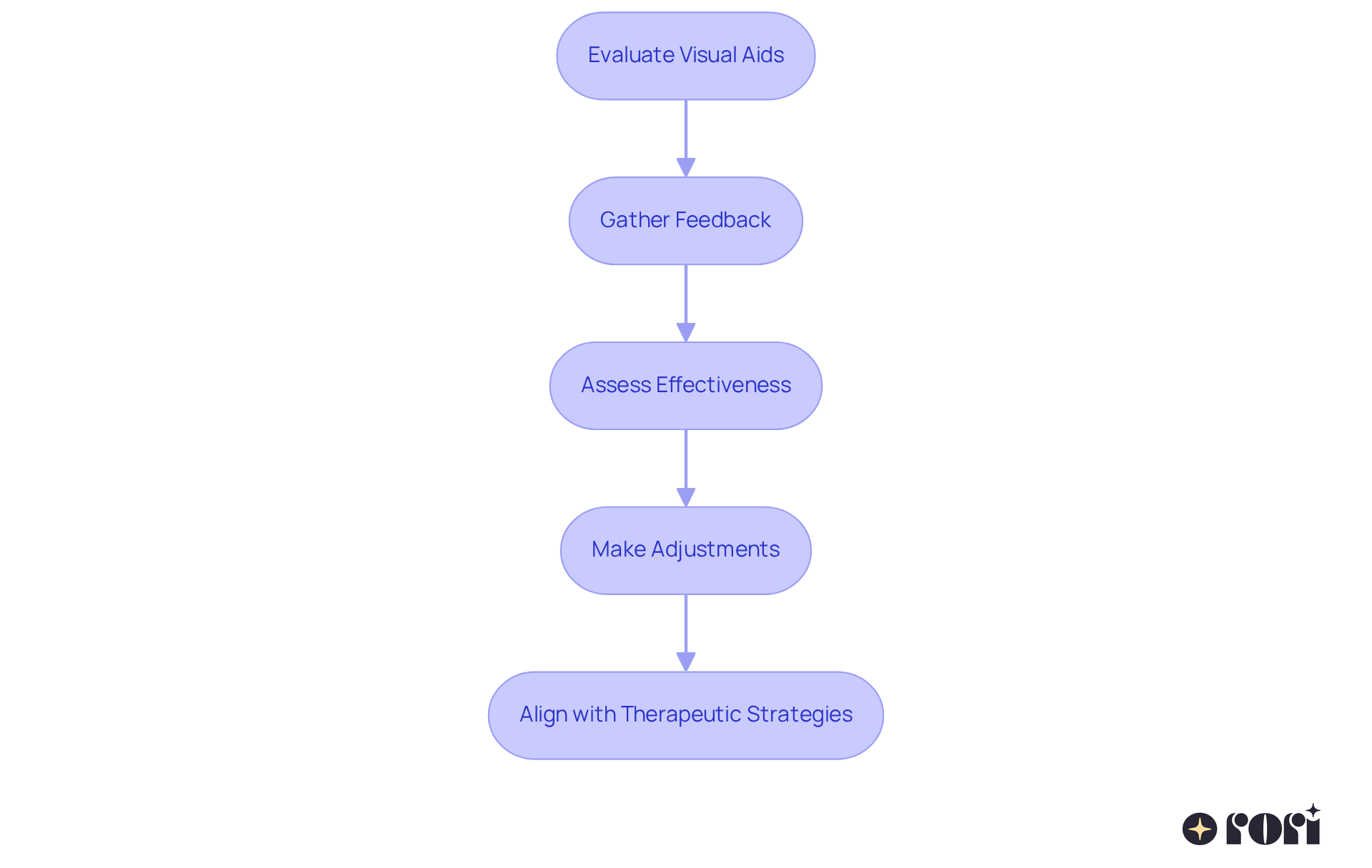Choosing the right visual aids for individualized autism care can be a game changer for supporting children on the spectrum. 🌈 These tools - like pictorial schedules and choice boards - bring clarity and structure, easing anxiety and promoting independence. But let’s be real: picking the most effective aids that fit each child’s unique needs can feel overwhelming.
So, how can caregivers navigate this tricky landscape? 🤔 It’s all about finding what works best for your child. We’re here to help you every step of the way! Let’s explore this together!
Choosing the right visual aids for individualized autism care is vital in supporting youth with autism, as it offers clear and concrete ways to help them understand their world. Think of them as friendly guides - pictures, symbols, and schedules that help simplify daily routines and complex ideas. 🌟 Research shows that these graphical aids can significantly reduce anxiety by bringing predictability and organization into their lives. This is especially important for kids on the autism spectrum, who often find changes in routine challenging.
For instance, pictorial schedules have been shown to boost on-task behaviors and enhance social interactions, all while fostering independence and confidence. By understanding how these visual resources work, caregivers and educators can incorporate them into personalized treatment plans, which is crucial for choosing the right visual aids for individualized autism care, ensuring that every child receives the tailored support they need to thrive.
Skilled behavior analysts enhance the effectiveness of their tools by choosing the right visual aids for individualized autism care, using evidence-based techniques like task analysis and graphical cues. Plus, ongoing assessment and adjustments to these plans allow for changes based on each child’s progress, ensuring they receive the support necessary to flourish. Let’s explore this together! We’re here to help you every step of the way!

To effectively implement visual aids, let’s begin by focusing on choosing the right visual aids for individualized autism care, considering the unique needs and preferences of your little one. Observing how they interact with different visuals can be quite revealing! Plus, chatting with parents and caregivers about what’s worked in the past can provide valuable insights. Think about factors like age, cognitive abilities, and sensory preferences. For instance, some kids might light up at vibrant images, while others may prefer simple black-and-white symbols.
Conducting preference assessments can really help pinpoint which visual aids will resonate best, which is crucial when choosing the right visual aids for individualized autism care to ensure the tools you choose are both effective and engaging. And here’s a thought: when you equip caregivers with knowledge about ABA principles and strategies, it boosts their ability to support your child’s behavioral goals. With a better grasp of these strategies, caregivers can make informed choices that positively impact your child’s progress. This leads to improved behavioral outcomes and a more cohesive support system at home.
Let’s explore this together! Your journey in understanding and supporting your child is important, and we’re here to help you every step of the way!

Choosing the right visual aids for individualized autism care is essential, as each one is crafted to meet specific needs and enhance learning experiences. Let’s take a look at some key types:
By thoughtfully selecting and using these instructional tools, caregivers can enhance their approach by choosing the right visual aids for individualized autism care to fit each young learner's unique preferences and needs. This approach can truly enhance their daily activities and overall growth. Let’s explore this together!

To effectively use supportive resources, it’s important to weave them into your child’s daily routines. Start small - introduce one or two aids at a time so your little one doesn’t feel overwhelmed. For instance, using a graphic schedule during morning routines can really help your child understand the order of tasks, like brushing their teeth, getting dressed, and having breakfast. Research shows that choosing the right visual aids for individualized autism care can enhance engagement and reduce challenging behaviors during transitions, making them a fantastic tool in autism therapy.
Consistency is key! Make sure to use those illustrative materials regularly and in the same context to reinforce their importance. Plus, choosing the right visual aids for individualized autism care can be significantly enhanced by training support providers on ABA principles and techniques. When caregivers are well-informed, they can make better decisions that positively impact their child’s progress and lead to improved behavioral outcomes.
Encouraging your child to engage with these teaching tools - like marking off completed tasks on a timetable - can foster a sense of achievement and independence. This approach not only deepens their understanding but also promotes active participation in daily activities, ultimately leading to better overall development and family dynamics. Let’s explore this together!

Regularly checking in on visual tools is essential for choosing the right visual aids for individualized autism care. When caregivers understand ABA principles and strategies, they’re better prepared to offer the right support at home. This not only complements professional interventions but also helps create a consistent environment for the child.
Gathering feedback from the child, parents, and therapists is key to seeing how well these tools are working. It’s worth asking:
Research shows that many autistic students learn best through visuals, highlighting the importance of choosing the right visual aids for individualized autism care to assess how these graphical techniques impact their learning outcomes.
With a solid grasp of ABA principles, caregivers can make informed choices that positively affect their child’s progress. Based on the insights gathered, adjustments might be needed. For instance, if a visual schedule seems too complicated, simplifying it by cutting down on the number of activities displayed can make it easier to use. On the flip side, if a child shows a preference for certain types of visuals, adding more of those can boost their engagement.
When caregivers actively participate and align with therapeutic strategies, it often leads to more effective and lasting behavioral improvements. Continuously refining instructional tools ensures they remain relevant and effective, ultimately supporting the child’s developmental journey.
As Yitz Diena points out, early intervention is crucial for individuals diagnosed with autism spectrum disorder (ASD), which underscores the importance of choosing the right visual aids for individualized autism care. Did you know that about 1 in 44 children in the U.S. are diagnosed with autism spectrum disorder each year? This really emphasizes the need for tailored approaches in autism therapy. Let’s explore this together!

Choosing the right visual aids for individualized autism care is so important for helping children on the spectrum feel understood and supported. By picking tools that fit each child's unique needs, caregivers can create a structured environment that reduces anxiety and boosts independence. Visual aids are like guiding stars, helping children navigate daily routines and social interactions, ultimately empowering them to explore their world with more confidence.
Throughout this article, we've shared some key insights about the significance of visual aids. There are various types available, like visual schedules, social stories, choice boards, and visual timers. Each of these tools tackles specific challenges faced by children with autism, making it essential for caregivers to consider individual preferences and needs. When caregivers implement these aids thoughtfully and regularly, they can really enhance engagement and learning outcomes, while also nurturing a sense of achievement in their children.
Ultimately, supporting children with autism through visual aids is a journey of continuous adaptation and growth. Regularly evaluating and adjusting these tools ensures they stay effective and relevant, aligning with each child's developmental path. By recognizing the importance of personalized visual aids and actively participating in the selection process, caregivers can truly make a difference in their child's life. This paves the way for better communication, understanding, and overall well-being. Let’s explore this together!
What is the role of visual aids in autism care?
Visual aids play a crucial role in autism care by providing clear and concrete ways to help youth with autism understand their world. They simplify daily routines and complex ideas, reducing anxiety by introducing predictability and organization.
How do visual aids benefit children with autism?
Visual aids, such as pictorial schedules, boost on-task behaviors, enhance social interactions, and foster independence and confidence in children with autism.
What factors should be considered when choosing visual aids for a child with autism?
Factors to consider include the child's age, cognitive abilities, sensory preferences, and how they interact with different visuals. Engaging with parents and caregivers can also provide valuable insights into effective visual aids.
How can preference assessments help in selecting visual aids?
Preference assessments help identify which visual aids resonate best with a child, ensuring that the chosen tools are effective and engaging for their individual needs.
What techniques do behavior analysts use to enhance the effectiveness of visual aids?
Behavior analysts use evidence-based techniques such as task analysis and graphical cues to enhance the effectiveness of visual aids in individualized autism care.
Why is ongoing assessment important in using visual aids for autism care?
Ongoing assessment allows for adjustments to be made based on each child's progress, ensuring they receive the necessary support to flourish.
How can caregivers be better equipped to support children with autism?
By providing caregivers with knowledge about Applied Behavior Analysis (ABA) principles and strategies, they can make informed choices that positively impact the child's behavioral goals and outcomes.